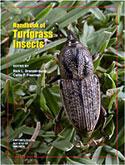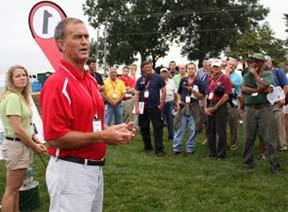 The second edition of the Handbook of Turfgrass Insects offers professional turf managers an inside look at what makes turf pests tick.
The second edition of the Handbook of Turfgrass Insects offers professional turf managers an inside look at what makes turf pests tick.
Edited by Rick Brandenburg, Ph.D., of North Carolina State University, and Callie Freeman, Ph.D., of Parker BioLabs LLC, the Handbook of Turfgrass Insects (Entomological Society of America and The American Phytopathological Society, $79.95 at www.shopapspress.org) contains current, thorough and practical information covering all aspects of turfgrass insect management in a streamlined format. All major insect pests and mites of warm- and cool-season turfgrasses in the United States are addressed. Extensive use of color photos of various insects and the turf damage they cause along with illustrations of insect life stages in their actual size, life cycle charts, and distribution maps help this new title to aid in accurate identification and diagnostics.
 The first edition is used by many of the top turfgrass training programs, and this new edition is designed to be utilized by a broad range of users, including golf course superintendents, sports turf managers, grounds maintenance personnel, sod producers, consultants, students, extension agents, pesticide applicators, master gardeners, teachers, students, entomologists, plant scientists, commercial lawn care professionals and anyone involved in the cultivation and care of fine turf. A helpful glossary, index and sources of local information also are included.
The first edition is used by many of the top turfgrass training programs, and this new edition is designed to be utilized by a broad range of users, including golf course superintendents, sports turf managers, grounds maintenance personnel, sod producers, consultants, students, extension agents, pesticide applicators, master gardeners, teachers, students, entomologists, plant scientists, commercial lawn care professionals and anyone involved in the cultivation and care of fine turf. A helpful glossary, index and sources of local information also are included.Brandenburg and Freeman have selected experts to cover harmful turf insects in concise, yet complete, individual sections that provide essential information on the key turfgrass pests that can damage golf courses and the turfgrasses found in commercial, residential, and sports settings. The benefit of having many authors involved in this book is that each section is written by the leading expert on that pest. The scientists who study these pests have brought Handbook of Turfgrass Insects, Second Edition, up to date with 16 years of new knowledge, including coverage of additional insects and effective new management strategies to make it even more useful than the first edition.

